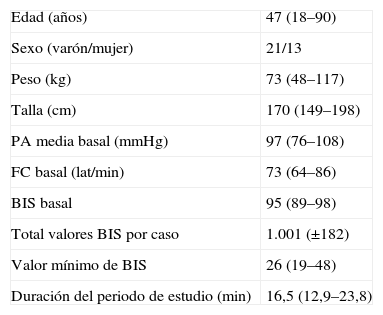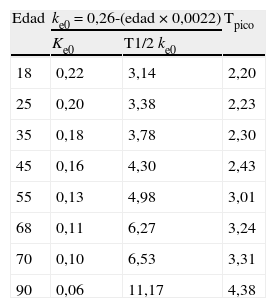La constante de primer orden que representa el equilibrio entre el plasma y el sitio efector (ke0) unifica la farmacocinética y la farmacodinamia de un fármaco. Esta constante se extrae para cada modelo farmacocinético específico y nos permite predecir el curso temporal del efecto en las perfusiones que usan TCI. El modelo PKPD de propofol publicado por Schnider et al. calcula un ke0 de 0,456min−1 con un correspondiente tiempo de efecto máximo (t peak) de 1,6min. El objetivo de este estudio fue reevaluar el valor del ke0 predicho por Schnider, con datos de una curva de efecto completa obtenida con control del BIS.
MétodosPacientes programados para cirugía electiva, con monitorización estándar y BIS XP, recibieron una perfusión de propofol en modo TCI para alcanzar una diana plasmática de 12 μg/ml en 4min. Alcanzada esta, se detenía la perfusión y se obtenía una curva completa de efecto (pérdida y recuperación de la conciencia). El programa Anestfusor (Universidad de Chile) fue usado para controlar los infusores y calcular las concentraciones según el modelo farmacocinético de Schnider, y además guardar los datos de BIS cada segundo. La pérdida (LOC) y la recuperación de la conciencia (ROC) fue evaluada y registrada. Usando un método paramétrico tradicional con el programa ke0 objectfix de PKPD tools, se extrajo el ke0 de cada individuo y de la población.
ResultadosTreinta y cinco pacientes adultos sanos (entre 18 y 90 años) fueron evaluados (21 varones y 14 mujeres) se obtuvo 1.001±182 datos EEG y sus correspondientes concentraciones plasmáticas calculadas. El ke0 poblacional obtenido fue de 0,144min−1±0,048, muy diferente del original (p<0,001). Este valor corresponde a un t peak de 2,45min. El rendimiento predictivo (Pk) para el nuevo modelo fue 0,9±0,03 pero solo 0,78±0,06 para el original (p<0,001). Partiendo de un BIS basal de 95,8±2,34, el BIS a LOC fue 77,48±9,6 y al ROC de 74,65±6,3 (p=0,027). La Ce calculada en el modelo original para LOC y ROC fue de 5,9±1,35 y 1,08±0,32 μg/ml respectivamente (p<0,001) y 2,3±0,63 y 2,0±0,65 μg/ml (p=ns) para el nuevo modelo. Los valores entre LOC/ROC fueron significativamente diferentes entre los 2 modelos (p<0,001). No se encontraron diferencias de sexo en el valor del ke0, pero sí se observó un impacto de la edad en el valor de ke0=0,26-(edad×0,0022) (p<0,05).
ConclusionesLas relaciones entre las concentraciones plasmáticas predichas por el modelo farmacocinético de Schnider y el efecto observado en el BIS fueron mejor caracterizadas con un valor de ke0 más pequeño (t1/2 ke0 más lento) que el del modelo original y con un impacto de la edad antes no descrito.
The first order plasma–effect-site equilibration rate constant (ke0) links the pharmacokinetics (PK) and pharmacodynamics (PD) of a given drug. This constant, calculated for each specific PK drug model, allowed us to predict the course of the effect in a target controlled infusion (TCI). The PK-PD model of propofol, published by Schnider et al., calculated a ke0 value of 0.456min−1 and a corresponding time to peak effect (t peak) of 1.6min. The aim of this study was to reevaluate the ke0 value for the predicted Schnider model of propofol, with data from a complete effect curve obtained by monitoring the bispectral index (BIS).
MethodsThe study included 35 healthy adult patients (18-90 years) scheduled for elective surgery with standard monitoring and using the BIS XP® (Aspect), and who received a propofol infusion to reach a plasma target of 12 μg/ml in 4min. The infusion was then stopped, obtaining a complete effect curve when the patient woke up. The Anestfusor™ (University of Chile) software was used to control the infusion pumps, calculate the plasma concentration plotted by Schnider PK model, and to store the BIS data every second. Loss (LOC) and recovery (ROC) of consciousness was assessed and recorded. Using a traditional parametric method using the “ke0 Objective function” of the PK-PD tools for Excel, the individual and population ke0 was calculated. Predictive Smith tests (Pk) and Student t test were used for statistical analysis. A P<.05 indicated significance.
ResultsThe evaluation included 21 male and 14 female patients (18 to 90 years). We obtained 1,001 (±182) EEG data and the corresponding calculated plasma concentration for each case. The population ke0 obtained was 0.144min−1 (SD±0.048), very different from the original model (P<.001). This value corresponds with a t peak of 2.45min. The predictive performance (Pk) for the new model was 0.9 (SD±0.03), but only 0.78 (SD±0.06) for the original (P<.001). With a baseline BIS of 95.8 (SD±2.34), the BIS at LOC was 77.48 (SD±9.6) and 74.65(SD±6.3) at ROC (P=.027). The calculated Ce in the original model at LOC and ROC were 5.9 (SD±1.35)/1.08 μg/ml (SD±0.32) (P<.001), respectively, and 2.3 (SD±0.63)/2.0 μg/ml (SD±0.65) (NS) for the new model. The values between LOC/ROC were significantly different between the 2 models (P<.001). No differences in ke0 value were found between males and females, but in the new model the ke0 was affected by age as a covariable (0.26-[age×0.0022]) (P<.05).
ConclusionsThe dynamic relationship between propofol plasma concentrations predicted by Schnider's pharmacokinetic model and its hypnotic effect measured with BIS was better characterized with a smaller ke0 value (slower t½ ke0) than that present in the original model, with an age effect also not described before.
Artículo
Comprando el artículo el PDF del mismo podrá ser descargado
Precio 19,34 €
Comprar ahora














